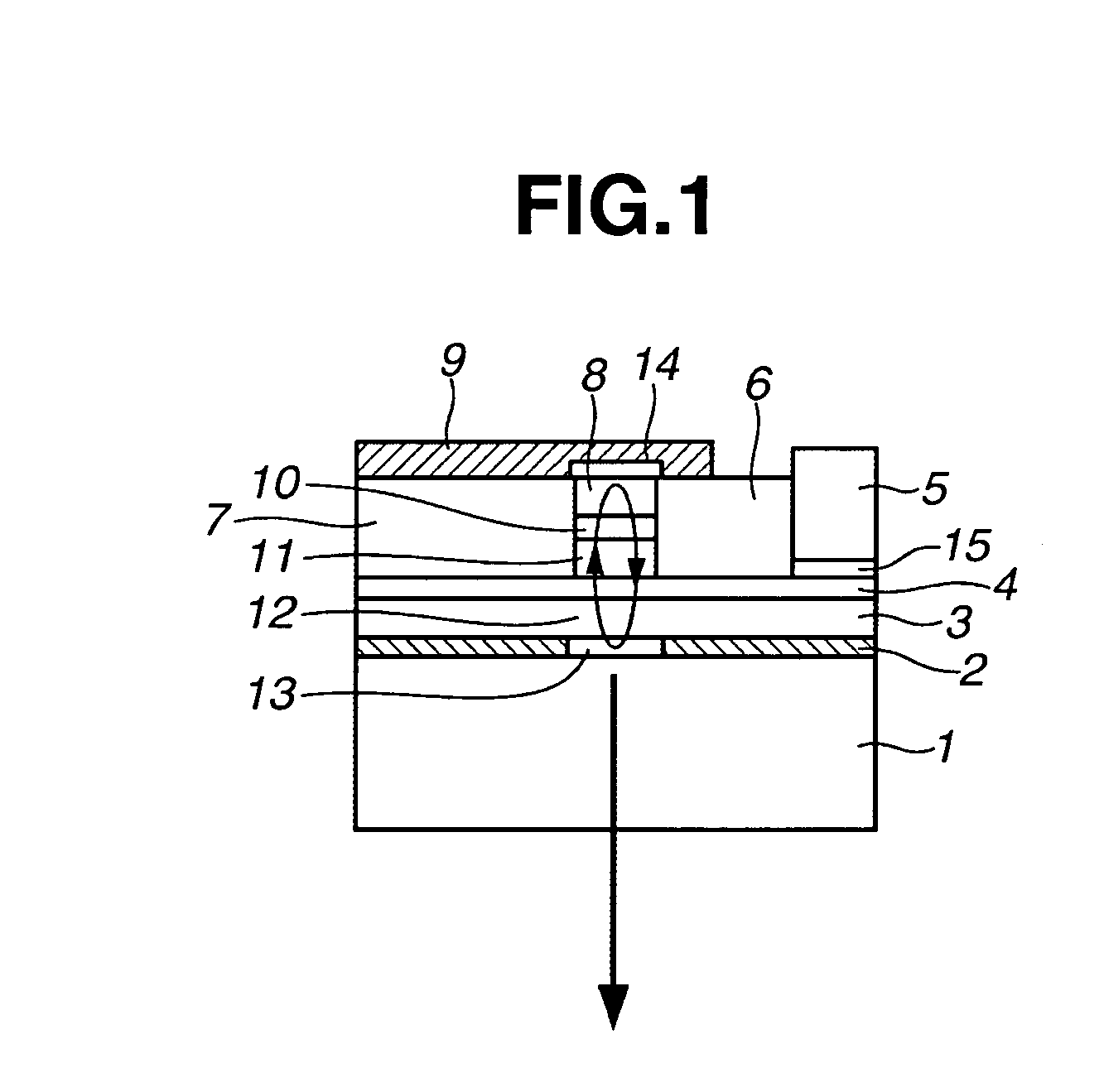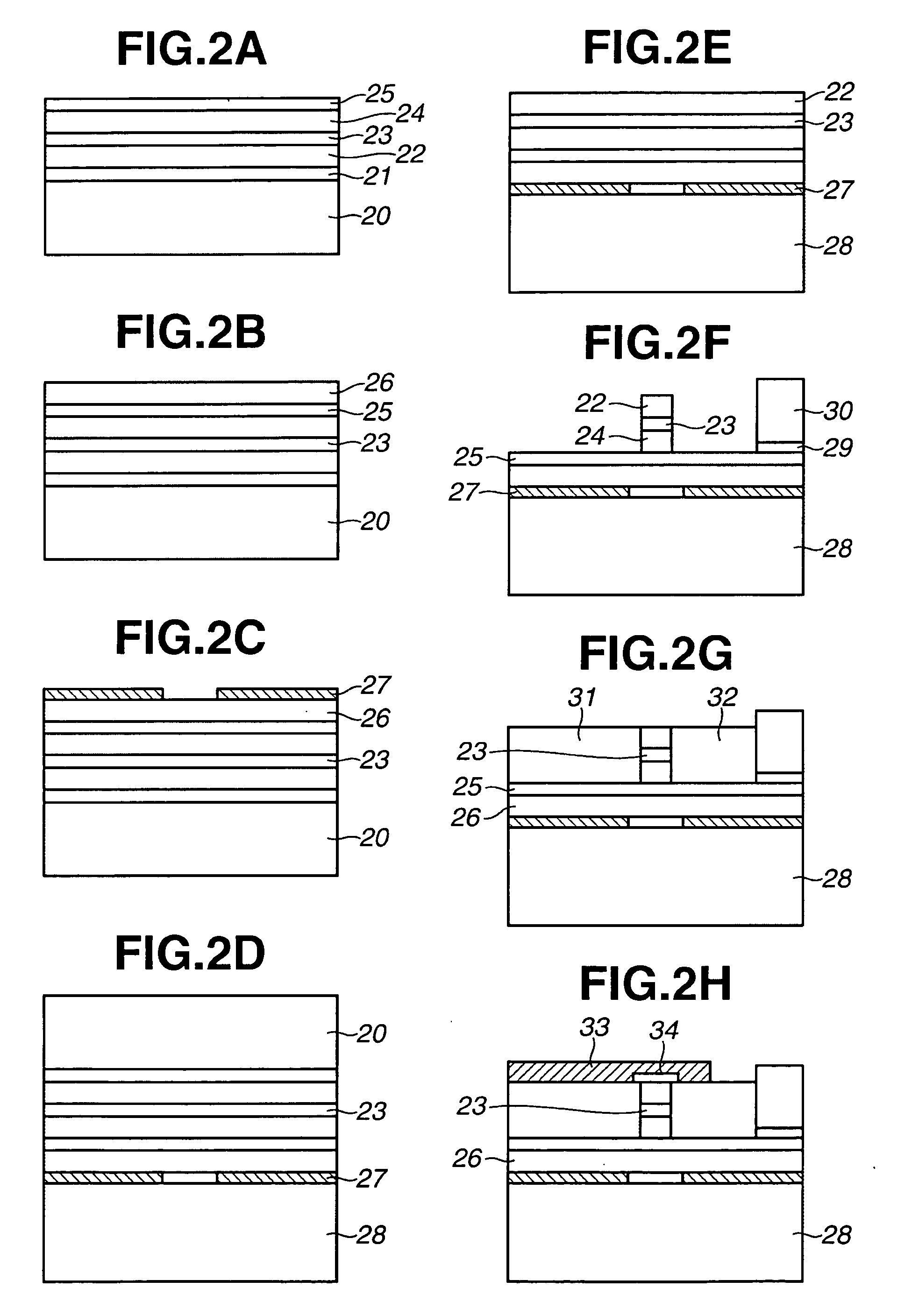Device for generating or detecting electromagnetic radiation, and fabrication method of the same
- Summary
- Abstract
- Description
- Claims
- Application Information
AI Technical Summary
Benefits of technology
Problems solved by technology
Method used
Image
Examples
first embodiment
[0029] A fabrication process of the first embodiment will be described with reference to FIGS. 2A to 2H.
[0030] As illustrated in FIG. 2A, an InP buffer layer 21, an InGaAs contact layer 22, an active layer 23 with the above-discussed InAlAs / InGaAs multi-layer structure, an InGaAs contact layer 24, and a heavily-doped InGaAs contact layer 25 are grown on an InP substrate 20 in an epitaxial manner using molecular beam epitaxy (MBE) or the like.
[0031] Then, as illustrated in FIG. 2B, an undoped Si spacer layer 26 is formed using chemical vapor deposition (CVD) or the like. An Au thin film 27 for the metallic mirror is then formed, and an opening for transmitting electromagnetic radiation therethrough is formed in the Au thin film 27, as illustrated in FIG. 2C.
[0032] After that, as illustrated in FIG. 2D, the wafer is bonded to a high resistivity Si substrate 28 with the metallic mirror 27 being used as a bonding face. Here, it is possible to employ a bonding method of using a resin a...
second embodiment
[0044] In the second embodiment, a Fresnel lens 37 for converging an emitted radiation beam is formed on a radiation emerging surface of the substrate 38, using etching or the like. In place of the Fresnel lens 37, an external lens can be used. This also holds true in other embodiments.
[0045] When the above dielectric multi-layer mirror is employed, there is no need to form an opening for transmitting electromagnetic radiation therethrough. Further, the reflectivity of the mirror can be regulated over a wide range by selecting materials and the number of layers in the multi-layer mirror. Therefore, the structure can be flexibly determined depending on the type of the device, i.e., a low threshold type or a high output type. For example, the low threshold type can be achieved when the number of layers is increased to enhance the reflectivity. Alternatively, the high output type can be achieved when the reflectivity on the radiation emitting side is reduced. The second embodiment is s...
fourth embodiment
[0049] In other words, the device of the fourth embodiment includes a substrate 50, a metallic mirror layer 51 with a plurality of openings, a spacer layer 52, an Si-high-doped InGaAs layer 53, Si-doped n-type InGaAs contact layers 57 and 59, active layers 58 with a quantum well structure having a semiconductor heterostructure, and burying layers 55. The active layer 58 generates a gain for electromagnetic radiation due to transition between subbands created in quantum wells in the quantum well structure. When the respective devices are provided at intervals of less than about 100 microns that is the oscillation wavelength, electromagnetic radiation is oscillated from the respective devices with a common-phase relationship maintained therebetween. Therefore, respective electromagnetic radiation waves interfere with each other so that a single beam of electromagnetic radiation can be emitted.
[0050] In the above structure, it is possible to cause oscillation and emission of electromag...
PUM
 Login to View More
Login to View More Abstract
Description
Claims
Application Information
 Login to View More
Login to View More - R&D
- Intellectual Property
- Life Sciences
- Materials
- Tech Scout
- Unparalleled Data Quality
- Higher Quality Content
- 60% Fewer Hallucinations
Browse by: Latest US Patents, China's latest patents, Technical Efficacy Thesaurus, Application Domain, Technology Topic, Popular Technical Reports.
© 2025 PatSnap. All rights reserved.Legal|Privacy policy|Modern Slavery Act Transparency Statement|Sitemap|About US| Contact US: help@patsnap.com



